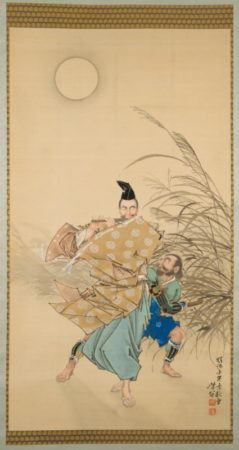
Woodblock Design and Painting Master Tsukioka Yoshitoshi Cast in New Light with Opening of Uncanny Japan: The Art of Yoshitoshi
Remembered as one of the greatest designers of the Japanese woodblock, Tsukioka Yoshitoshi (1839-1892) is the subject of an upcoming exhibition at the Worcester Art Museum (WAM). Uncanny Japan: The Art of Yoshitoshi surveys the artist’s prolific career and his innovation in print at a time when the medium was facing increasing competition from photography and lithography. On view from February 28 to May 24, 2015, Uncanny Japanfeatures an assortment of Yoshitoshi’s signature works-images of horror and cruelty, supernatural creatures, commanding acts of bravery by legendary figures from Japanese history, samurai images, and sensitive portraits of contemporary women.
 The exhibition draws special attention to his masterpiece, the scroll painting Fujiwara no Yasumasa Playing the Flute by Moonlight (1882), considered to be one of the most significant works of Japanese art in the Worcester Art Museum’s collection, as well as one of the most important Japanese works held by an American museum. Uncanny Japan also includes two other paintings by the artist, which are rare since Yoshitoshi worked primarily in the medium of woodblock prints.
The exhibition draws special attention to his masterpiece, the scroll painting Fujiwara no Yasumasa Playing the Flute by Moonlight (1882), considered to be one of the most significant works of Japanese art in the Worcester Art Museum’s collection, as well as one of the most important Japanese works held by an American museum. Uncanny Japan also includes two other paintings by the artist, which are rare since Yoshitoshi worked primarily in the medium of woodblock prints.
Yoshitoshi’s tumultuous life and work mirror one of the most transformative periods in Japanese history, when the country changed from a feudal to a modern society emulating Western ways of government and social conduct. As Japan was rapidly changing, the medium of the woodblock print, in which Yoshitoshi had been trained, was becoming outdated in the face of new, modern, reproduction techniques, and struggling for relevance in representing the changing urban landscape. Uncanny Japan reinforces the sense of Yoshitoshi as an artist living between two eras and invites new ways of understanding his life and artistic trajectory.
“During Yoshitoshi’s lifetime,” says Katherine Brooks, the exhibition’s curator, “restrictions enacted by the previous military government that forbade artists from representing members of the ruling class were lifted. Thus, Yoshitoshi’s many depictions of contemporary events further reveal the changing artistic environment of his age, and new attitudes about the parameters of ‘art.'” In addition, Yoshitoshi’s designs often “make use of new chemical dyes, such as striking reds and purples, which were newly synthesized and applied to this traditional practice.”
Exhibition part of Museum’s Master Series
Uncanny Japan: The Art of Yoshitoshi is the latest entry in WAM’s Master Series, which offers a fresh perspective on some of the world’s most celebrated artists. On view in different galleries throughout the Museum, the select Master Series installations cover a range of time periods and mediums, from Raphael’s seminal work The Small Cowper Madonna (about 1505) on loan from the National Gallery of Art in Washington, D.C., to such WAM collection highlights as Yoshitoshi’s Fujiwara no Yasumasa Playing the Flute by Moonlight(1882). Each Master Series artwork is coupled with a dedicated art program on the third Thursday of each month, which uses the canvas as a portal for developing a more nuanced understanding of some of the most pivotal figures in art history.
Uncanny Japan: The Art of Yoshitoshi, will be the focus of the Worcester Art Museum’s sixth and last Master Series Third Thursday event for this year. Taking place on Thursday, May 21 at 6pm, the evening will feature a presentation on historic Japanese flutes by composer Shirish Korde. In addition, flutist Alice Jones will perform three musical pieces, including Korde’s famed “The Tenderness of Cranes.” The program is free with Museum admission.
